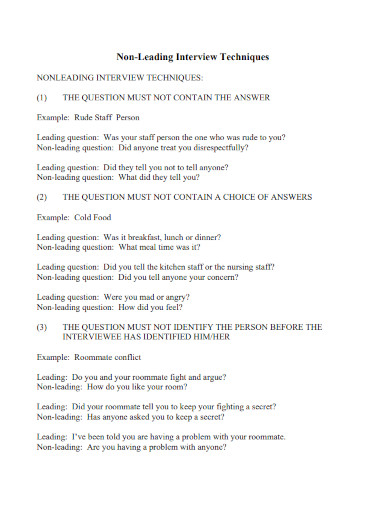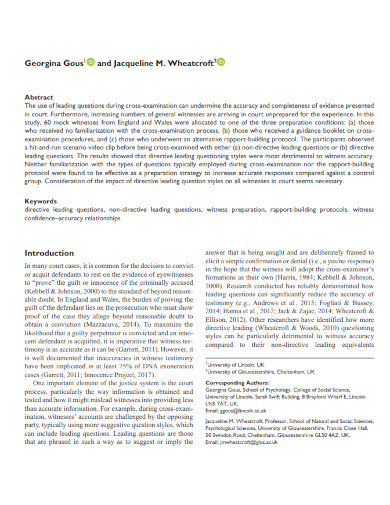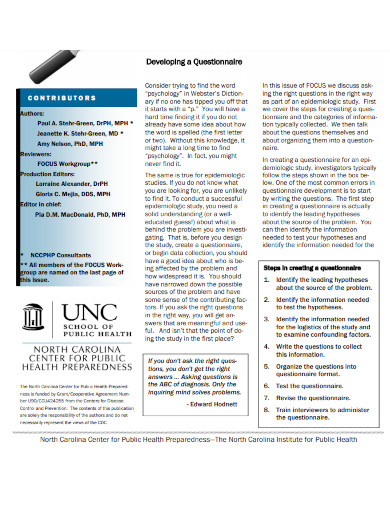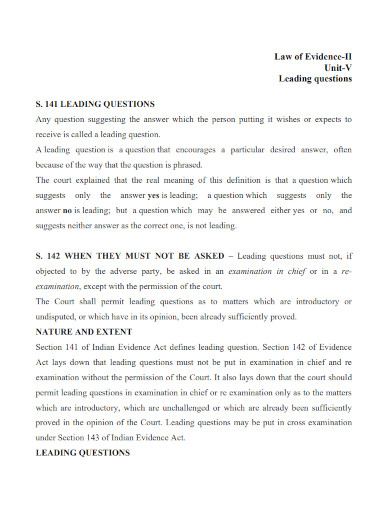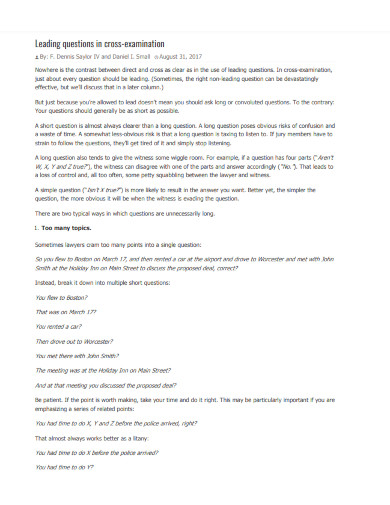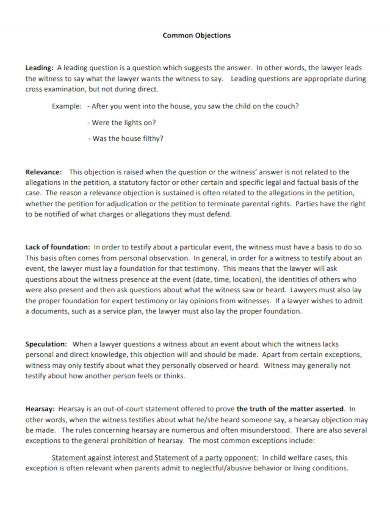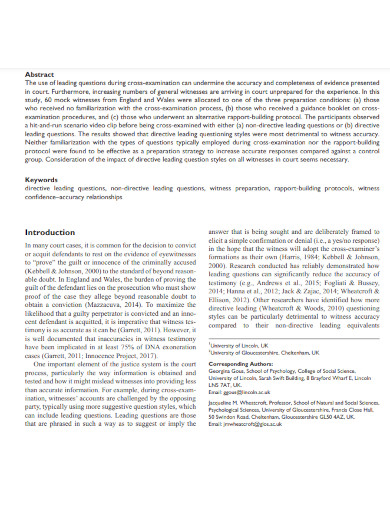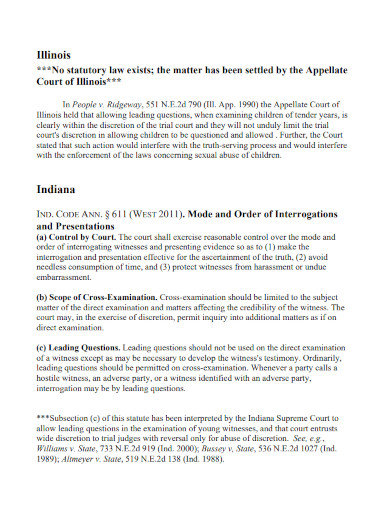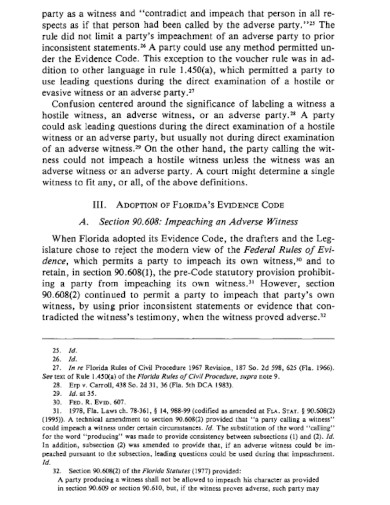9+ Leading Question Examples to Download
Some questions are structured in such a way that a specific answer will be obtained either consciously or unconsciously. These questions are called leading questions and have some practical and impractical usage of this technique depending on the context.
1. Non-Leading Interview Techniques
2. Directive Leading Questions
3. Developing a Leading Questionnaire
4. Law of Evidence Leading questions
5. Leading Questions in Cross Examination
6. Leading Questions on Direct Examination
7. Directive Leading Questions and Preparation Technique
8. Leading Questions Activity Sheet
9. Leading Questions and Child Witnesses
10. Using Leading Questions During Direct Examination
What Are Leading Questions
Leading questions are a type of questions that will “lead” a person to a specific answer, conclusion, or thinking. This is considered a very persuasive form of questioning that is often used in court proceedings and cross-examination. But this is a highly avoided line of questioning when used for quantitative or qualitative research.
How to Avoid Leading Questions
Leading questions are very dangerous when they are placed in surveys. This is because they will lead to logical fallacies and a misinformed conclusion. Unlike court proceedings where a lawyer can use leading questions to cross-examine, you cannot develop leading questions in a survey as it will undermine the scientific method.
Step 1: Write the Question as Clearly as Possible
One of the best ways to reduce the number of leading questions in your survey is through the simplification of all the questions posed in said survey. This means that the question should be phrased in a simple structure rather than a compound-complex, compound, and complex sentence structure.
Step 2: Ask an Expert to Read Your Questions
Sometimes it is very difficult to remove yourself from your own biases. This means that you should let someone outside of the survey group or an expert who knows about the topic read and provide feedback on the questions provided.
Step 3: Provide All Answers Possible to the Question
Some leading questions are created when their answers are skewed toward a specific point or inclination. To prevent this from happening you must provide all the possible answers available in the survey question.
Step 4: Uncomplicate the Answers
Some complicated answers will unintentionally lead to a specific conclusion, which in turn will make a leading question. This means that you must try and simplify all the answers to the survey questions you have provided.
FAQs
How do leading questions affect one’s survey and survey questions?
Leading questions lets the survey-taker try to answer in a specific way that will lead to either confirmation bias or other types of biases and logical fallacies. This means that the result generated by a survey question that is leading will always be skewed to a specific answer or trend. The skewed answers will in turn lead to inaccurate and untruthful data that will undermine the whole purpose of the survey. Not only that, but leading questions can also break the attention and commitment of the reader if they will notice the leading question. The break in attention and commitment will lead to them not answering the other questions genuinely. All of these indicate the consequences and the negative effects of using leading questions in one’s survey.
What are the different types of leading questions in surveys?
There are five different types of leading questions a person can use in surveys that will lead to skewed answers and data points. The first type of leading question is called a leading question with an interconnected statement that precedes the question, planting a specific thought into the answerer’s head. An example of this type of leading question is “A lot of our employees do not like the sitting desks. Do you feel the same way?” The second type of leading question is the direct implication, which tries to connect a specific outcome to a possible reaction. Using a similar example as the one above, “If our standing desk is up to your standards, will you recommend our product to your coworkers?” The third type of leading question refers to the usage of scales that are skewed to one side. An example of this type of leading question is “How satisfied were you with the quality of the standing desk? (Answers are) Absolutely satisfied, satisfied, somewhat satisfied, somewhat dissatisfied, and dissatisfied.” The fourth type of leading question is called an assumption-based leading question, which tries to shoehorn a specific type of response. An example of this is “How great are our standing desks?” The final type of leading question is called a coercive leading question, which aggressively shoehorns a specific response from the survey taker. An example of this type of leading question is “Our standing desk sufficiently met your needs, didn’t it.”
Why is it important to give leading questions in cross-examinations?
Leading questions in court lend to a more persuasive line of dialogue that will favor the person asking said questions. Not only that but it will also allow you to have a dialogue that is not open-ended and will not swing out of the person’s favor. This line of questioning is not acceptable in direct examination whilst being appropriate for cross-examination, which means that the lawyer can make their case by using leading questions and connecting them to evidence and the witness’ testimony. This in turn will allow the lawyer to present their point of view.
Leading questions is a type of question that will try to create or lead the listener or viewer to a specific conclusion or answer. When creating survey questions, leading questions are very dangerous and will lead to inaccurate and untruthful answers.



